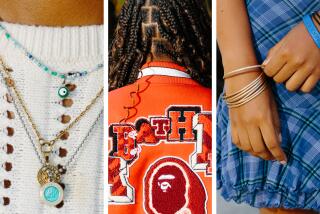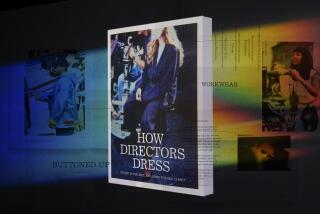FIT TO BE HIRED
- Share via
Flip through any how-to book on job interviewing and you’re bound to run into the same timeworn tenets on how to dress when facing the hiring squad.
“A conservative two-piece business suit” is appropriate for men and women, according to “The College Grad Hunter” (2008) by Brian D. Krueger, with women clad in pantyhose “at or near skin color.”
Susan Britton Whitcomb, author of “Interview Magic” (2008), suggests that men wear “a sharp navy blazer and dress slacks” when interviewing at companies with a casual atmosphere.
Slacks? Pantyhose? Are we still getting gussied up the way they did in “Mad Men” to get hired?
The short answer, in many fields, is yes. But this is Southern California, where more than a few creative-minded companies consider board shorts or cropped jeans appropriate business attire. Significant swaths of the local job market have their own dress codes -- which makes choosing a solid interview outfit all the more difficult.
And with unemployment in California at 11% in April, employers often find themselves choosing among candidates who look nearly identical on paper. That’s when looking impressive in the flesh can tip you right into the catbird seat.
We asked executives from the creative, business and entertainment fields which looks work -- and which ones don’t -- for job seekers in their areas.
First, they agreed on a few universal rules:
Be well groomed: This would seem to go without saying, but based on employer comments, it’s worth repeating. Don’t even bother walking through those double doors with a ratty pedicure, dirty shoes or clothes or greasy hair.
Kimber Maderazzo, senior vice president of global product development for personal-care juggernaut Guthy-Renker, said she notices chipped nails and grown-out hair roots -- and though she frowns upon drag queen-heavy makeup, “even women who don’t usually wear makeup should wear a little on an interview,” she said. “They need to look polished.”
Pay attention to the details, because it’s the little things that seal the deal: Sure, you’ve never worn a sweat suit on a job interview -- but employers agree that it’s almost never the core outfit (the suit, the skirt) that makes the big impression.
Thomas McCullough, executive vice president and chief operating officer for First Regional Bank, remembers an experienced banker who interviewed for a position at his office whose small -- but significant -- sartorial snafu ended up costing him the job.
“He was dressed very nicely and expensively,” McCullough said, “but he had a big poufy Hollywood scarf hanging down from his pocket. As soon as I saw him, I said to myself, ‘He’s not going to get the job. He’s gone Hollywood on us.’ It’s a small thing, but he just went a little outside our comfort zone.”
Karine Dubner, chief operating officer of fashion companies Joie and Current/Elliott, once escorted an overeager job candidate to another part of the office, only to find that the interviewee could barely walk in her towering stilettos. “It made me feel uncomfortable,” Dubner said.
Dress for the conference room, not for the club: Think modesty. For women, low-cut shirts, too-short skirts and bare upper arms are no-nos. Skirts should be knee-length, jackets should have the capacity to close (even if they’re left open), and second-to-top buttons on shirts should be affixed. Men should leave the bedazzled jeans at home and refrain from showcasing their chest hair -- at all.
Remember that polish counts: Don’t show up for an interview looking like you gave zero thought to your ensemble. It’s better to risk being overdressed than look as if you just stopped by on your way to the beach.
“I’d rather see someone be a little more polished and conservative than too casual,” said Karine Joret, president and co-founder of lifestyle and fashion public relations firm HL Group, “like, ‘I’m too cool, I’m too hip for this meeting.’ ”
Playing to win: Beyond mastering those basics, the real key to success is discovering as much about the company’s corporate culture as you can before sitting down for the interview. By donning the office “uniform” -- which may be dark jeans at MTV or a Gucci suit at a legal office -- you make it easier for potential employers to envision you integrating seamlessly into their team.
How to go about getting the skinny on the sartorial scene? Peruse the company website for photos of staffers in action, call the human resources department to tactfully inquire after the company’s dress code or -- for super- sleuths -- send a “lost” friend into the office ahead of time to ask for directions and report back on what people are wearing (but remember to dress a tad more formally than the staffers do day to day).
Our interviews with the executives yielded these general guidelines for dressing to kill in various fields.
--
Finance, law and banking
One word: conservative. This means donning a dark, well-cut suit for guys, a skirt-suit or pantsuit for gals and black, polished dress shoes for all (and guys, skip the unflattering sneaker-loafer hybrids from brands such as Skechers and invest in a good pair of black lace-ups). The dreaded nude pantyhose would be in order for women. But a briefcase on the first interview was deemed unnecessary -- and might even come off as an affectation.
The days of dressing casually in the banking business “never were,” noted McCullough, who also wears suits on the weekend out of habit.
A senior manager at a major international financial services firm in L.A., who was only permitted to comment anonymously, said anything other than a plain black suit -- for men and women -- would be inappropriate for an interview at his company. “We all wear black suits and blue shirts,” he said. “It shows that you understand the corporate culture if you dress the same.”
--
High-level sales, marketing and real estate
Sartorial codes tend to be slightly less rigid in these pressure-cooker fields -- but not by much. Jay Luchs, executive vice president of commercial real estate and office leasing company CB Richard Ellis, said he likes to see men interview in suits -- any dark hue will do -- and women in skirts with blouses or dresses and heels.
“The Internet days changed things big time for a lot of people,” he noted. “People were dressed more casually for a while. Now they’re going back to realizing it might be better to show up dressed more ‘business attire.’ It shows you’re more serious.”
--
Creative fields
Fashion, publishing, architecture, graphic design and lifestyle public relations firms usually boast more lax dress codes. The general rule is that the more creative the job (think fashion designer, graphic artist), the more liberties you can take when dressing for the big interview. And showing that you’re in the dark regarding certain fashion nuances is more likely to count against you in these visually driven industries.
Tammy Hammond, director of recruiting for action sports brand Quiksilver -- where the top execs wear flip-flops to shareholder meetings -- said, “Professional means something else to us. If you show up in a suit, it’s apparent that you don’t understand the culture. And for us, cultural fit is 80% of what we’re looking for. There are a lot of people who can do the job.”
For men, clean jeans and a collared shirt, “and even a nice T-shirt,” is plenty gussied up, Hammond said. “Girls can wear jeans and a cute blouse or sandals, or a cute T-shirt that’s layered with something fashiony.”
But T-shirts wouldn’t fly at the majority of fashion companies in SoCal. Joie’s Dubner, for example, is OK with nice dark jeans, as long as they’re dressed up with a blazer, “nice shoes and [for women] a beautiful bag.”
Adam Watson, a freelance Web designer based in Glendale, regularly scores gigs in a uniform of dark jeans or khakis, clean Pumas and a dark-hued collared polo shirt. “If you go in with a suit or tie as a designer, you’re not going to be perceived as a very creative person,” he said.
Kim Calvert, editor in chief of lifestyle magazine Singular and website SingularCity.com, said business casual is the right note to strike when interviewing at the publication’s office, which the staff shares with pet dogs and a bird. Nice jeans and a button-front shirt are appropriate for men, she added, and ensembles that “show you’re paying attention to fashion and staying abreast of the media” work for women.
--
Entertainment industry
There are as many types of jobs in the entertainment industry as there are kernels in a bucket of popcorn, but even if you’ll be heading to a film editing suite -- where you could easily spend all day barefoot, if you wish -- the rules for interview dressing for office and production jobs are similar. The nice-jeans-and-blazer look will cut it, but you’re far safer in a pair of flat-front pants, casual button-front shirt and a blazer (for guys) and a dress or blouse-and-skirt combo (for gals).
Still, in a few Hollywood offices, personal style trumps formality.
Ryan Patterson, supervising producer for celebrity news show “Access Hollywood,” said her office recently hired a guy who came to his interview dressed in a button-front shirt thrown over a rock concert T-shirt, jeans, a newsboy cap, tons of silver jewelry and Puma sneakers because “he looked cool,” she said, “like he’d be hanging out with stars he’d be interviewing.”
Patterson recommends a blazer and jeans with nice sneakers for men and “a cute dress that you accessorize with funky jewelry” for the ladies on interview day.
But too-cool-for-school won’t work at film company Apartment 3B Productions, said Jennifer Klein, founder and president. “I would never wear jeans to an interview. I don’t care if they are $200 jeans -- no way. Why risk it?” she said. “I’ll remember the geek in the suit over the guy with the T-shirt with food down the front.”
Klein recommends keeping an interview ensemble “basic and professional,” which boils down to well-fitting suits for men and a flattering skirt-and-blouse ensemble with nice heels for women. She warns against looking fashionable to an intimidating degree. “You feel like that person might be competing with you,” she said. And keep super-pricey bags (like Hermes Birkin bags, which start at around $6,000) at home. “I’m going to hire the girl from Oklahoma who seems more hungry instead of the girl from Bel-Air who might have a great work ethic but she looks like she doesn’t need a job,” she said.
With so many nuanced rules in each industry, your best bet for striking the right tone in your interview ensemble is by doing your homework -- researching the company’s corporate atmosphere. Because you don’t want a pair of inappropriate Nikes to hamstring your chances. You’re better than that.
--
More to Read
Inside the business of entertainment
The Wide Shot brings you news, analysis and insights on everything from streaming wars to production — and what it all means for the future.
You may occasionally receive promotional content from the Los Angeles Times.










